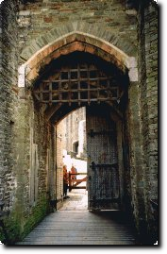© 1999-2003 by Marvin Hull
A portcullis was a heavy grilled door that dropped vertically down through slots or guides, and most often protected the main entrance of the castle. It could be made of many different materials, but almost all were made of oak, then plated with iron. On the bottom were spikes. The raising of the heavy portcullis was sometimes assisted with counter weights, pulleys, and rope.
Often times a quick release device was used to quickly lower the portcullis. When the castle came under attack, a guard could take a sledge hammer and hit the release latch. The portcullis would quickly drop closed.
The portcullis went through development stages. It was invented by the Romans in 208 B.C. and began showing up in castle construction in the 12th Century. One of the last stages saw it incorporated into the drawbridge. When raised, the drawbridge lowered. When lowered, the drawbridge went up. Some castles had more than one portcullis.
If you visit a castle today you can actually see the slots that guided the portcullis up and down. Not many actual portcullis survive in modern times because of the material used in their construction. Since most were made of wood, they quickly decayed.
Which castle had the most portcullises? This is unclear, but Beaumaris castle in North Wales was designed to have six, three for each gatehouse.
Some examples of castles that still have a portcullis are Hever, Warwick, and Caldicot.

